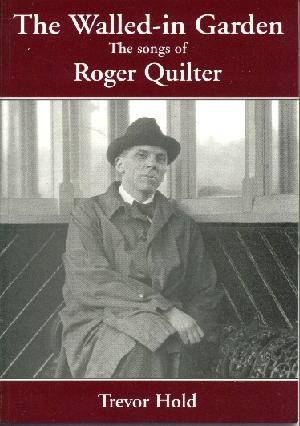Book Review
The Walled-In Garden – The songs of Roger Quilter
By Trevor Hold.
64 pages; Paperback. Thames Publishing 1978 and 1996. £7:50
ISBN 0 905210 99 9
AmazonUK AmazonUS

This is not a new publication. I picked it up, from the publishers’ stall at the memorable Finzi Friends event, ‘A Weekend of English Song’ at Ludlow this year, knowing that I would find it useful when lecturing on English song.
"Ask any singer and he or she will tell you that a Quilter song is a delight to sing. Find any pianist who does not admit that his accompaniments are exactly calculated and a delight to play." So summarises Trevor Hold in this valuable short appreciation of the English songwriter whose songs appealed to the leading singers of his day including Gervase Elwes, Ada Crossley, Plunket Greene, Muriel Foster and John Coates.
Trevor Hold is himself a composer and poet and is therefore eminently qualified to assess Quilter’s songs – and although he is quick to sing Quilter’s praises he does not pull his punches. One might wonder why Hold has chosen one of Quilter’s lesser songs as the title of his book. Hold explains: "Quilter’s greatest limitation…is his lack of vision. The title of one of his later songs, ‘The Walled-in Garden’ could aptly serve as a metaphor to summarise his career. He is content to cultivate a small plot of ground with neatly-trimmed lawns and a variety of exquisitely fragrant flowers. One wishes at times, that he would look over the wall and describe to us the countryside beyond…"
Yet, as Hold admits, when Quilter was at the peak of his creative powers (between 1905 and 1910), "...if Elgar was the symphonic master of Edwardian age, then Quilter was its most typical and representative songwriter." Before Quilter, aspirations of English songwriters were "pathetically low…drawing room fripperies…[with music and lyrics] sententious and self-pitying, banal in language and false in sentiment." "Quilter showed great care in word-setting and was very conscious of the needs and limitations of the singers. Of paramount importance, as he declared, was "keeping the musical line".
As Quilter was influenced by Maude Valerie White, who had shown a modest attempt to raise the artistic level of the drawing room ballad, so would Quilter influence the succeeding generation of songwriters particularly Peter Warlock.
The opening pages give a brief survey of Quilter’s life. As a young man he seems to have been vivacious and high spirited but later shy and withdrawn. A botched operation blighted his career and tragically he suffered a severe mental decline in his later years and died completely insane. We still await a definitive biography of Roger Quilter.
Hold assesses all the songs, dismissing rather peremptorily, all the songs written in the composer’s later years and the Four Child Songs Op 5 as smug and patronising. The charm of The Lamplighter has clearly not disarmed him. Of the extremely popular ‘Now Sleeps the Crimson Petal’, Hold has mixed feelings – "…within its modest aims this is deserved, though one wishes that Quilter had set the poem as Tennyson had written it. In fact he sets only the outer stanzas of the poem omitting the three central couplets. In doing so he not only ruins the subtlety of Tennyson’s exquisite lyric but also misses the musical opportunities that the original verse-form give. The song is also flawed by some commonplaces towards the end." Amongst Hold’s short list of Quilter’s finest creations are: ‘Come Away Death’ from Three Shakespearean Songs; ‘The Night Piece’ and Julia’s Hair’ from To Julia, ‘Go, Lovely Rose’ and ‘By a Fountainside’ from Seven Elizabethan Lyrics.
A much-needed and balanced assessment of Roger Quilter’s art.
Ian Lace